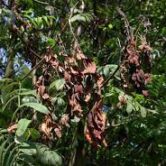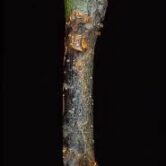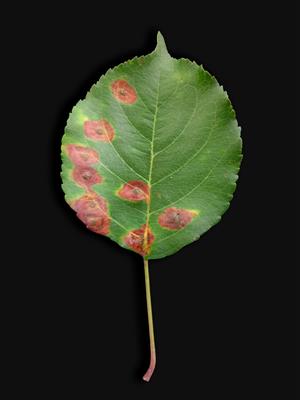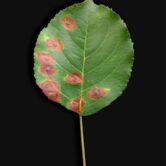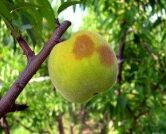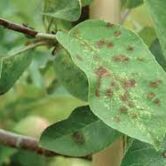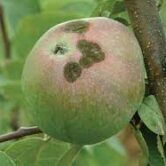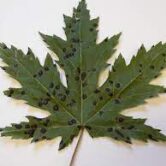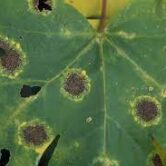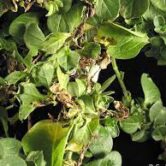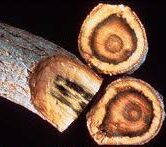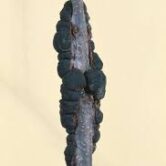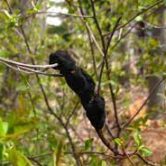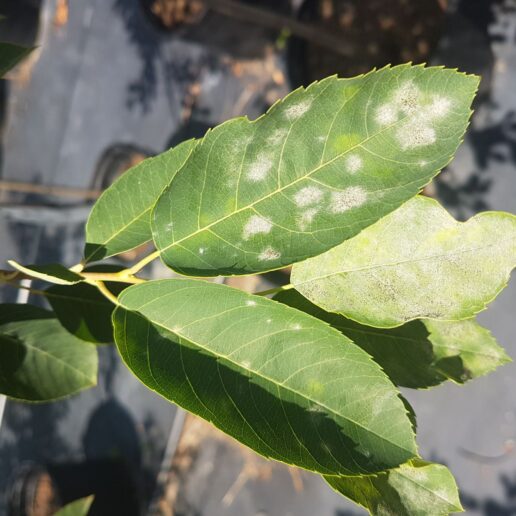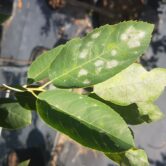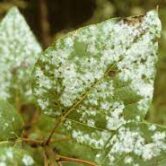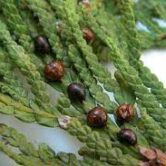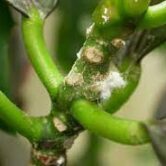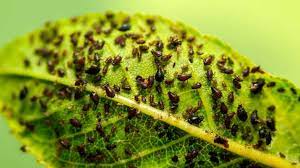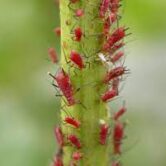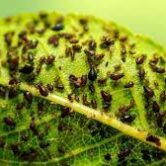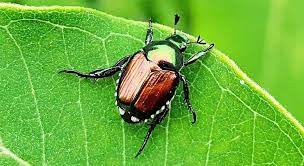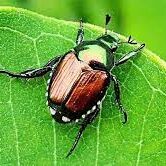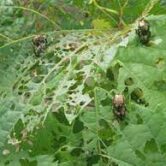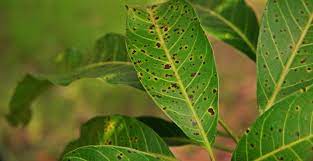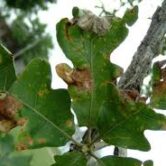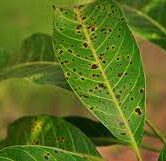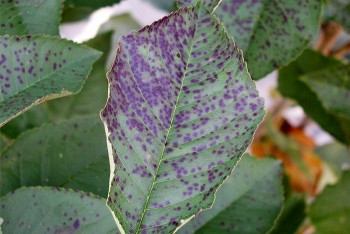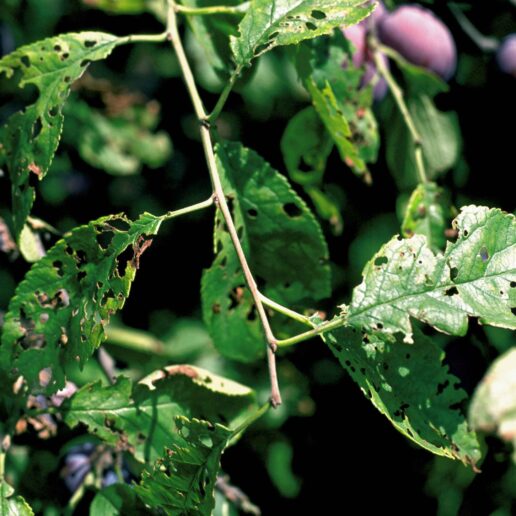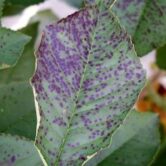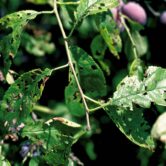Tips for a tree that looks sick or unhealthy
Note that a sick or unhealthy tree does not mean that it is doomed! A tree is a living being that can get sick, but can also heal.
Why is your tree in bad shape?
Several factors can have an impact on the health of a tree:
- environmental stress: drought, extreme heat, strong winds, frost, ice, etc.;
- growing conditions that are not suitable for the needs of the tree: insufficient sunlight, compact or poorly drained soil, nutrient deficiency, inadequate soil pH, etc.;
- mechanical damage: injury or breakage caused by the lawn mower or edger, by landscaping work, etc.
- diseases, pest infestations (insects, mites) or damage caused by mammals or birds.
What to do if your tree is in bad shape?
- Take the time to examine it thoroughly, assess its growing conditions and review your care practices.
- Consult the different sections of our guide on the diseases and pests you may face.
- If necessary, ask us or an arborist for advice.
For more information, you can consult the espace pour la vie website.
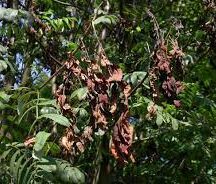
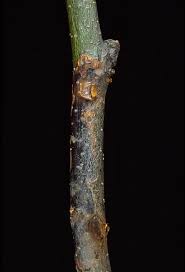


Bacterial blight
Description: This bacterial disease is common in several species of Rosaceae. It spreads very quickly and can be fatal for the tree. The infection spreads like fire, especially during a hot, humid and rainy spring. The damage resembles burns: the flowers and young shoots eventually wilt and then dry out and turn black, but often remain attached to the plant. The bark of infected branches takes on a reddish-brown hue well demarcated from the healthy parts.
Scouting: Early in the spring, before leafing out, examine the twigs to speed up any discoloration of the bark. At the time of flowering, inspect the flowers and young shoots because this is when the disease spreads most rapidly. Continue inspection until mid-summer.
Physical Control: Prune back infected branches immediately, make the cut in healthy tissue at least 30-50 cm (12-20 inches) below any visible discoloration on the bark, and always prune in dry weather. Sterilize pruning instruments between each cut with 70% isopropyl alcohol (rubbing alcohol). Rake up and destroy infected leaves and fruit that deposit on the ground and discard all cutting residues and infected debris.
For more information : https://espacepourlavie.ca/carnet-horticole/pests-and-diseases/brulure-bacterienne-des-rosacees https://aimfc.nrcan.gc.ca/en/diseases/factsheet/176
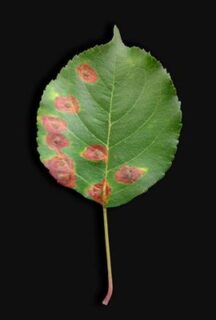
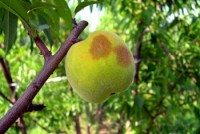
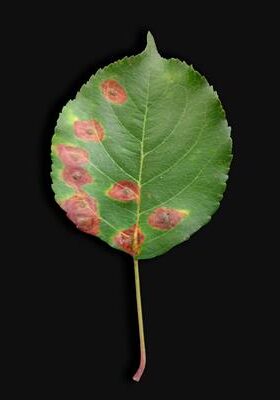

Rust
Description: Rosaceae affected by rust fungus develop yellow to orange spots and swellings on the leaves, fruits or twigs. Warm, humid temperatures promote fruiting bodies and windy conditions help spread the spores.
Scouting: Inspect foliage in early spring. Small pale yellow spots appear on the upper surface of the leaves and on the fruits shortly after flowering. The lesions enlarge and take on a more orange hue, often surrounded by a reddish outline. Sooner or later, small black dots (spermogonia) appear in the center of the lesions. Towards the end of summer, receptacle-like structures appear on the underside of the leaves and on the fruits.
Preventive measures: Avoid planting near junipers and deciduous trees of the Rosaceae family, which serve as alternate hosts for the fungus.
Physical Control: During winter or early spring, cut and discard branches infected with galls or fruiting bodies. Disinfect pruning tools with 70% isopropyl alcohol (rubbing alcohol).
During summer and fall, rake up and destroy infected leaves and fruit as they fall.
Cut down and destroy trees that are too severely infected; do not compost diseased plant debris.
For more information :
https://espacepourlavie.ca/carnet-horticole/pests-and-diseases/rust-of-juniper
http://www.omafra.gov.on.ca/IPM/english/apples/diseases-and-disorders/cedar-apple-quince-rust.html
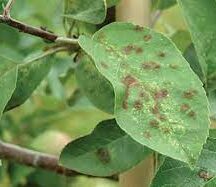
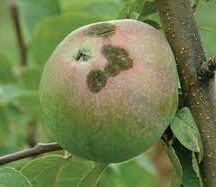
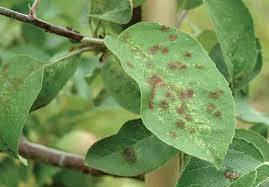
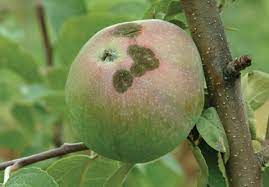
Scab
Description: Scab-causing fungi are favored by cool, wet weather and the risk of infection is greatest in the spring, during periods of rapid leaf and fruit growth. Apple trees, crabapple trees and pear trees are particularly affected. The disease is characterized by the appearance of numerous circular lesions (scabs) on leaves and fruits. Severe infection can cause severe defoliation and greatly reduce fruit quality.
Scouting: Inspect foliage regularly beginning in early spring. In a tree affected by scab, small circular, olive-coloured, velvety-looking spots appear first. At a more advanced stage, the lesions turn black and slightly raised. Heavily infected leaves may turn yellow and drop prematurely.
Scab can also cause spots, cankers (sores) and kill young twigs, especially on pear.
Early infection can cause young growing fruit to drop or distort (tissue does not develop at the spots). Late infection marks mature fruits with corky scabs, similar to those on the foliage.
Preventive measures: Maintain the vigor of the trees by irrigating them regularly and particularly in times of drought. Avoid drastic pruning and excessive nitrogen fertilizers which encourage the rapid growth of tender shoots that are more vulnerable to infection.
Physical Control: Pick up and discard infected leaves and fruit as they fall to the ground. Never compost infected plant debris.
Chemical control: In case of severe infection there or in previous years, use a preventive low-impact pesticide whose active ingredient is sulphur, calcium sulphide or calcium polysulphide (lime sulfur or sulfur mixture). Read the product label carefully and follow the manufacturer’s recommendations.
For more information :
https://espacepourlavie.ca/carnet-horticole/pests-and-diseases/pommier-and-pear-tree-scab
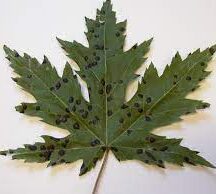
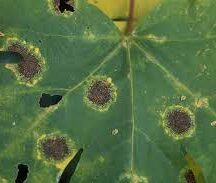
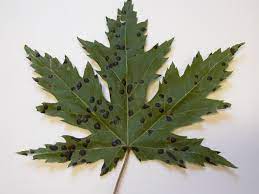
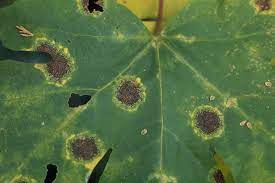
The tarry spot
Description: This fungal disease is favored by a rainy spring. Severe infection can cause premature leaf drop. However, the damage is mostly cosmetic; they rarely endanger the life of the trees.
Scouting: In late spring and early summer, pale yellowish or greenish spots appear on the upper leaf surface. Around mid-summer, these spots take on a black color and a tarry appearance.
Preventive measures: Maintain the vigor of the trees by irrigating them regularly, particularly in times of drought. However, avoid wetting the foliage so as not to favor the dispersal and germination of the spores.
Physical Control: Pick up and dispose of fallen infected leaves to prevent new infections.
For more information :
https://espacepourlavie.ca/carnet-horticole/pests-and-diseases/spot-goudronneuse-de-lerable
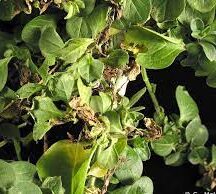
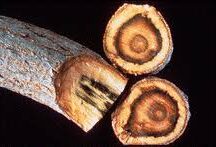
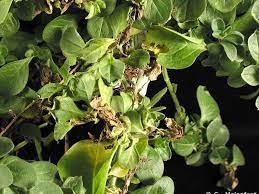

Verticillium wilt
Description: The disease is characterized by the sudden wilting of foliage, followed by the drying of twigs and branches. The infection is transmitted by contaminated seeds, cuttings, tubers, soil and water.
The first signs look like water stress (lack of water). We observe a sudden wilting of the foliage at the end of certain branches, more frequently those at the bottom; then the leaves turn yellow, dry up and fall prematurely. At a more advanced stage, the infection causes the withering, then death, of young twigs and branches, then of the entire tree.
Scouting: Observe plants regularly during the growing season. If in doubt, cut a withered branch to see if there are dark rings in the vascular system or check under the bark for brownish or greenish longitudinal streaks.
Preventive measures: Maintain the vigor of the trees by irrigating them regularly, particularly in times of drought. Avoid injury to the roots (pickaxe, spade, harrow, tiller) and aerial parts of the tree (mower, blower).
Physical control: Prune affected trees and remove all dead wood; prune infected branches down to healthy wood. Disinfect cutting tools regularly with 70% isopropyl alcohol (rubbing alcohol).
For more information :
https://espacepourlavie.ca/carnet-horticole/pests-and-diseases/verticillium-wilt
https://www.phyto.qc.ca/fiche.php?nomal=28&noesp=172&nolist=82&gr=1&pl=
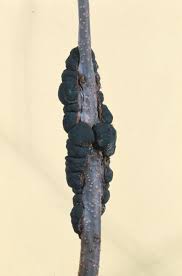
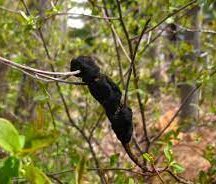

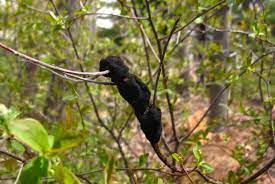
The black knot
Description: This fungal disease particularly affects plum and cherry trees. Infected twigs and branches bear cylindrical, rough, sooty-looking black growths (nodules). Once completely encircled, the sections above the nodules die off. Initial infection occurs in early spring, but the first symptoms do not appear until a few months later, towards the end of summer on susceptible cultivars or the following spring on more resistant cultivars.
Scouting: Inspect branches in early spring and regularly throughout the growing season. We first see a slight bulge appear at the base of the young shoots of the year or on the branches.
During the growing season, the fungus grows in the vascular system and expands. Bloated branches crack; greenish, fluffy growths fill the created cavities. This velvety appearance indicates that the fungus is fruiting and releasing spores. Towards the end of the summer, the nodules turn brown, take on a corky appearance and then become hard and black as coal.
Preventive measures: Maintain the vigor of the trees by irrigating them regularly, particularly in times of drought.
Physical Control: During dormancy (late fall, winter), prune infected branches before spring growth resumes. Pruning old nodules eliminates overwintering spores that contaminate new growth.
During the growing season, remove nodules as they form. Cut the branches about 10 cm below the base of the nodules.
Take care to clean the tools between each cut with 70% isopropyl alcohol (rubbing alcohol).
Chemical control: As a last resort, use a low-impact pesticide whose active ingredient is calcium sulfide or calcium polysulfide (lime sulfur or sulfur slurry) or sulfur. Read the product label carefully and follow the manufacturer’s recommendations.
For more information :
https://espacepourlavie.ca/carnet-horticole/pests-and-diseases/nodule-black
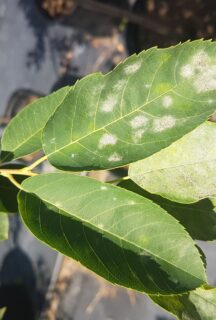
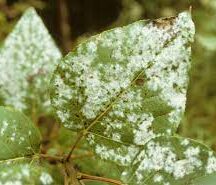
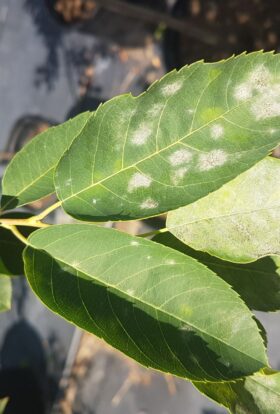
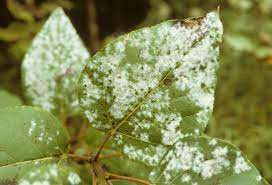
Powdery mildew
Description: The infection covers the tissues with powdery or fuzzy spots, sometimes lined with small black dots. Damage usually appears around mid-summer.
Scouting: We first notice the appearance of a thin whitish film or spots, generally located on the top of the leaves. The damage remains superficial and the spots can easily be rubbed off to see the still healthy surface of the leaf.
At a later stage, the white spots thicken and take on a fluffy, powdery appearance (summer spores).
In the case of severe or recurrent infections, the down can invade all the tender parts of the plant and cause them to dry out.
Preventive measures: Maintain the vigor of the trees by irrigating them regularly and particularly in times of drought. Plant susceptible species in sunny, well-ventilated locations; respect the planting distances. Avoid drastic pruning and excessive nitrogen fertilizers which encourage the rapid growth of tender shoots that are more vulnerable to infection.
Physical control: Prune and discard infected parts of annuals and perennials; regularly sanitize cutting tools with 70% isopropyl alcohol (rubbing alcohol).
In hot, dry weather, sprinkling the foliage with water can help reduce the development of the fungus; avoid wetting the foliage at the end of the day so as not to favor other types of fungal diseases.
In the fall, rake up and dispose of infected leaves to reduce the overwintering population, the main source of contamination in the spring.
For more information :
https://espacepourlavie.ca/carnet-horticole/pests-and-diseases/white-or-powdery-mildew
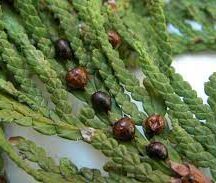
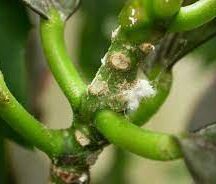
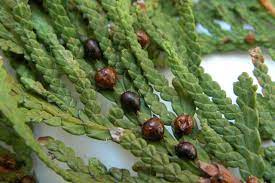
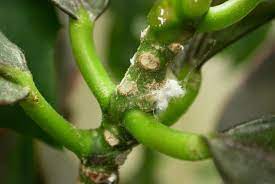
Scale insects
Description: The cochineal superfamily (Coccoidae) includes several genera of sucking insects that can harm trees and fruit or ornamental shrubs. Depending on the species, mature mealybugs look like small, bulging scales, miniature shells, or small, flattened discs covered in waxy secretions. In small numbers, mealybugs cause little damage, but large colonies can kill entire branches by sucking up the sap.
Screening: Regular visual inspection remains the best method of detection. During the summer, the presence of honeydew, sooty mold, ants or wasps are good indicators. Ants protect scale insects and transport young larvae to new sites. A large amount of honeydew is a sign of a serious, unnoticed infestation.
Preventive measures: Inspect plants regularly. Early identification allows local intervention and prevention of infestations that are more difficult to control.
Prevent injury and avoid overdoses of fertilizer that stimulate the growth of tender, inviting shoots for sucking insects.
Physical control: First prune dead branches or branches that are too heavily infested to reduce the insect population. Take care to regularly disinfect pruning tools. Eliminate all visible scale insects. Dead or alive, they can harbor hundreds of eggs under their shell or in their ovisac. Living mealybugs are more difficult to detach from the bark, but dead mealybugs disintegrate easily.
On the trunk and large branches: scrub with a soft brush dipped in soapy water; take care not to damage the bark.
On the leaves and young twigs: rub with a soft cloth or a toothbrush soaked in soapy water. Brush insects occasionally with a cotton swab dipped in rubbing alcohol to dry them out.
Repeat the treatment if necessary to ensure that the entire population is eliminated. A few forgotten eggs or insects are more than enough to rebuild a new colony.
Biological control: Encourage the presence of natural predators and parasites (bugs, ladybugs, hoverfly larvae, parasitic wasps) by cultivating a wide variety of plants.
Chemical control: As a last resort, use a low-impact pesticide whose active ingredient is insecticidal soap or mineral oil (horticultural oil). Read the product label carefully and follow the manufacturer’s recommendations.
For more information :
https://espacepourlavie.ca/carnet-horticole/pests-and-diseases/rustic-mealybugs
https://pepinierevilleneuve.com/cochenille-farineuse/
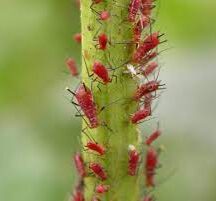
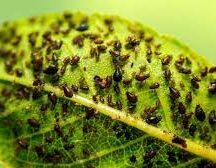
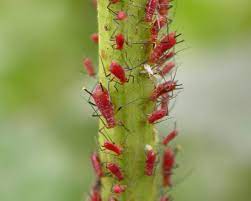
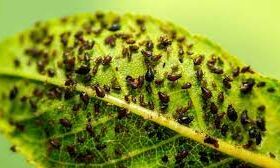
Aphids
Description: These very prolific little insects feed on the sap of many ornamental and food plants. They form dense colonies on young shoots and under the leaves, but they also feed on the stems, barks, roots and fruits of plants. They excrete a sweet, sticky substance (honeydew) that attracts ants, wasps and bees, among others, and promotes the development of a black fungus (sooty mold). Their incessant pumping weakens the plants and causes the discoloration, deformation and even premature fall of the leaves.
Scouting: Infested leaves turn yellow, wilt, curl, distort and may drop prematurely; Starting in the spring, regularly inspect the plants to spot aphids before they cause too many problems. Pay particular attention to the underside of leaves and the tips of new shoots. The presence of honeydew and the coming and going of ants can also be indicators of the presence of aphids.
Preventive measures: Avoid drastic pruning and excessive nitrogen fertilizers which favor the rapid growth of tender shoots. Maintain the vigor of the trees by irrigating them regularly and particularly in times of drought.
Physical control: Dislodge aphids with a powerful jet of water; repeat treatment as needed. Prune and discard excessively infested stems and leaves; manually crush the insects grouped on the plant.
Biological control: Aphids have many natural enemies (ladybugs, lacewings, hoverfly and midge larvae, spiders, birds, braconids, etc.). Encourage their presence by growing a wide variety of plants. Common tansy, marigold and marigold are some of the species that attract aphid predators.
Chemical control: As a last resort, use a low-impact pesticide whose active ingredient is insecticidal soap. Read the product label carefully and follow the manufacturer’s recommendations.
For more information: https://espacepourlavie.ca/carnet-horticole/ravageurs-et- Maladies/puceron#:~:text=Intercaler%20quelques%20plantes%20pi%C3%A8ges%20dans,can%20server%20de %20plants%20h%C3%B4tes.
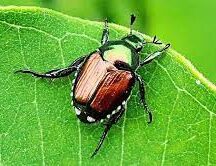
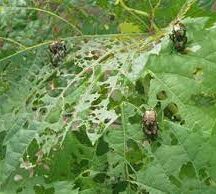
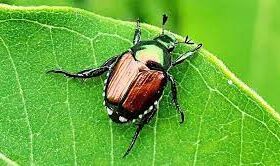
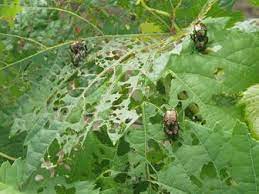
Japanese beetle
Description: It is a pest that attacks the leaves and inflorescences of many trees, shrubs and cultivated plants (250 host plants). Lawn is the preferred host for the larval stages. The adults appear in the summer and are very active for about 6 to 8 weeks. they shred the interveinal tissue, only a leaf skeleton disappears. The beetles normally feed in groups from the top of the plants, working towards the base.
Scouting: There is no need for special scouting for Japanese beetle. Adults are easy to spot.
Control : At the first signs of infestation, drop the beetles in a jump of soapy water to prevent their pheromones from attracting others and causing the damage to increase.
There doesn’t seem to be a perfect (and especially immediate) solution to Japanese beetle control. Most of the time, the tree managed to make new leaves following the period of pest activity.
Beware, although the pheromone and flower baits sold with the traps are very effective and trap many beetles every day, research has shown that the traps attract more beetles than they capture. Therefore, susceptible plants are near the traps that may suffer more once the traps are set.
For more information: https://inspection.canada.ca/plant-protection/invasive-species/insects/japanese-beetle/fact-sheet/eng/1328165101975/1328165185309
https://www.iriisphytoprotection.qc.ca/Fiche/Insect?imageId=3173
https://www.omafra.gov.on.ca/IPM/english/apples/insects/japanese-beetle.html#advanced
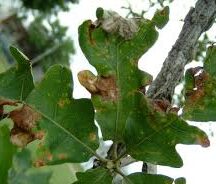
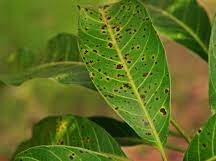
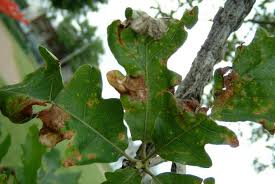
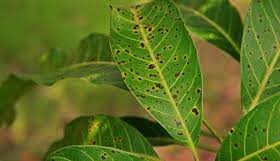
Anthracnose
Description: The term “anthracnose” groups together a number of diseases caused by microscopic fungi. Infection is common but damage is usually minor. In severe cases, leaves dry up and fall prematurely, fruits rot, and cankers (sores) develop on young twigs of trees and shrubs. The incidence of anthracnose fluctuates from year to year, depending on climatic variations.
Scouting: The first signs appear on young leaves as discolored circular spots or irregular necrotic lesions. The leaves appear parched by a hot, dry wind or scorched by frost, depending on the season.
The fungi then invade the vascular system, causing petioles to dry up and leaves to drop prematurely. At an advanced stage, small black dots can be seen on the leaves.
Trees in the shade are more affected than those growing in full sun, as their foliage stays moist longer.
Anthracnose does not usually kill trees but can weaken them.
Preventive measures: Maintain the vigor of the plants by irrigating them in times of drought. Avoid wetting the foliage so as not to favor the dispersal and germination of the spores.
Control: On young trees, remove the first affected leaves by hand when the foliage is dry.
Pick up and dispose of fallen leaves to reduce disease spread.
For more information : https://espacepourlavie.ca/carnet-horticole/ravageurs-et-maladies/anthracnose
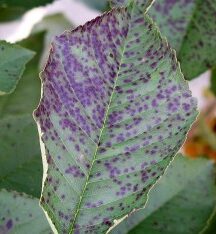
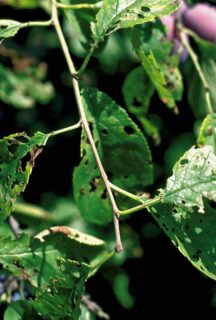
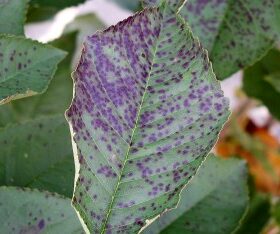
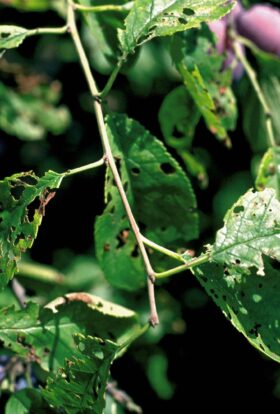
Shot hole disease
Description : Shot hole disease is caused by a fungus which affects the foliage of plants of the Prunus genus. If the disease is not controlled and defoliation is significant for several years in a row, affected trees become more susceptible to winter injury and lose vigor.
Scouting : The infection produces small round or angular spots, purple or red, which eventually turn brown with tissue death. Typically, dead tissue sloughs off, leaving holes in the leaf. If humidity is high, a mass of white spores may appear on intact lesions on infected leaves. In case of severe infection, the lesions may join together and form large areas of necrotic tissue, the leaves may appear chlorotic, and early leaf fall may be observed.
Preventive measures : Collect and dispose of dead leaves that have fallen to the ground. Irrigate in the morning so that the foliage dries as quickly as possible; splashing water on the leaves leads to the spread of the disease.
Physical control : As no fungicide is registered against this disease, pruning and sanitation are the only control measures available.
For more informations : https://www.agrireseau.net/documents/Document_96553.pdf https://agriculture.canada.ca/en/agricultural-production/pest-control-agriculture/agroforestry-pest-diseases/cherry-cribure-virginia
https://reseaupommier.irda.qc.ca/?p=14661
